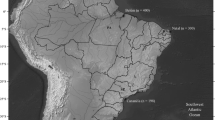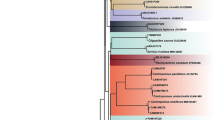Abstract
Due to the morphological similarity between some billfish species, the International Commission for the Conservation of Atlantic Tunas (ICCAT) recommends the use of molecular tools to identify billfish at the species level to properly manage this imperiled group. In this study, species-specific swordfish and billfish identification was carried out by using PCR-RFLP and multiplex PCR of the mitochondrial COI gene. Samples were obtained during landings of the tuna fleet at the Public Fisheries Port of Santos (PFPS) and in the General Warehouse Company of São Paulo (CEAGESP), Brazil. A total of 87 samples from PFPS were identified: Kajikia albida, Tetrapturus georgii, T. pfluegeri, Makaira nigricans, and Istiophorus platypterus. At CEAGESP, 432 individuals were collected, and three species were detected: Xiphias gladius, I. platypterus and T. georgii. Some samples presented an unknown band pattern for PCR-RFLP, which were sequenced and identified as X. gladius. These findings demonstrate that billfishes protected by law are being caught by industrial fisheries, but they are not traded at the CEAGESP. We advocate continuous onboard and of landings fishing monitoring using molecular identification tools in accordance with ICCAT recommendations. We provided evidence that DNA-based methods are efficient in overcoming billfish misidentification in the Atlantic Ocean.



Similar content being viewed by others
Change history
08 May 2021
A Correction to this paper has been published: https://doi.org/10.1007/s12686-021-01211-w
References
Amorim AF, Arfelli CA (2001) Analysis of the Santos fleet from São Paulo, southern Brazil (1971–1999). Col Vol Sci Pap ICCAT 53:263–271
Arocha F, Marcano LA, Marcano JS, Gutierrez X, Sayegh J (2001) Captura incidental observada de peces de pico en la pesqueria industrial de palangre venezolana en el Mar Caribe y en el Atlantico centro-occidental: 1991–1999. Col Vol Sci Pap ICCAT 53:131–140
Arocha F, Marcano LA (2001) Monitoreo de grandes peces pelagicos en el Mar Caribe y el Atlantico centro-occidental mediante un programa integrado de monitoreo en Venezuela. In: Proceedings of the Gulf and Caribbean Fisheries Institute, Conference workshop, 52:557–76. http://aquaticcommons.org/id/eprint/13441.
Beerkircher L, Arocha F, Barse AM, Prince ED, Restrepo V, Serafy J, Shivji M (2009) Effects of species misidentification on population assessment of overfished white marlin Tetrapturus albidus and roundscale spearfish T. georgii. Endanger Species Res 9:81–90. https://doi.org/10.3354/esr00234
Bernard AM, Shivji MS, Domingues RR, Hazin FHV, Amorim AF, Domingo A, Arocha F, Prince ED, Hoolihan JP, Hilsdorf AWS (2013) Broad geographic distribution of roundscale spearfish (Tetrapturus georgii) (Teleostei, Istiophoridae) in the Atlantic revealed by DNA analysis: implications for white marlin and roundscale spearfish management. Fish Res 139:93–97. https://doi.org/10.1016/j.fishres.2012.10.009
Bingpeng X, Heshan L, Zhilan Z, Chunguang W, Yanguo W, Jianjun W (2018) DNA barcoding for identification of fish species in the Taiwan strait. PLoS ONE 13:1–13. https://doi.org/10.1371/journal.pone.0198109
Chapman DD, Abercrombie DL, Douady CJ, Pikitch EK, Stanhopen MJ, Shivji MS (2003) A streamlined, bi-organelle, multiplex PCR approach to species identification: application to global conservation and trade monitoring of the great white shark, Carcharodon carcharias. Conserv Genet 4:415–425. https://doi.org/10.1023/A:1024771215616
Chow S (1994) Identification of billfish using mitochondrial cytochrome b gene fragment amplified by polymerase chain reaction. Collective Volume of Scientific Papers, Report of Second ICCAT 41:549–56. http://fsf.fra.affrc.go.jp/chow/paper/BillID.pdf.
Collette BB, Carpenter KE, Polidoro BA, Juan-Jordá MJ, Boustany A, Die DJ, Elfes C, Fox W, Graves J, Harrison LR, McManus R, Minte-Vera CV, Nelson R, Restrepo V, Schratwieser J, Sun CL, Amorim A, Brick Peres M, Canales C, Cardenas G, Chang SK, Chiang WC, Oliveira Leite N, Harwell H, Lessa R, Fredou FL, Oxenford HA, Serra R, Shao KT, Sumaila R, Wang SP, Watson R, Yáñez E (2011) High value and long life-double jeopardy for tunas and billfishes. Science 333:291–292. https://doi.org/10.1126/science.1208730
Damasceno J, Siccha R, Oliveira C, Mendonça F, Lima A, Machado L, Tosta V, Farro A, Hostim-Silva M (2016) Molecular identification of Atlantic goliath grouper Epinephelus itajara (Lichtenstein, 1822) (Perciformes: Epinephelidae) and related commercial species applying multiplex PCR. Neotrop Ichthyol 14:e150128. https://doi.org/10.1590/1982-0224-20150128
Domingues R, Okuda G, Bernard A, Amorim A, De Biasi J, Hilsdorf A (2015) A DNA tool for the identification of heavily exploited Atlantic billfishes. Conserv Genet Resour 7:807–809. https://doi.org/10.1007/s12686-015-0489-4
Ehrhardt N, Fitchett M (2016) Status of billfish resources and billfish fisheries in the western central Atlantic. FAO Fisheries and Aquaculture Circular No. 1127. Bridgetown, Barbados http://www.fao.org/3/a-i6204e.pdf.
Ellis R (2013) Swordfish a biography of the ocean gladiator, 1st edn. University of Chicago Press, Chicago, USA
Fiedler FN, Port D, Giffoni BB, Sales G, Fisch F (2017) Pelagic longline fisheries in Southeastern/South Brazil. Who cares about the law? Mar Policy 77:56–64. https://doi.org/10.1016/j.marpol.2016.12.011
Freire K, Aragão JA, Araújo A, Silva A, Bispo M, Velasco G, Carneiro M, Gonçalves F, Keunecke K, Mendonça J, Moro P, Motta FS, Olavo G, Pezzuto P, Santana R, Santos R, Trindade-Santos I, Vasconcelos J, Vianna M, Divovich E (2015) Reconstruction of catch statistics for brazilian marine waters (1950–2010). Fish Cent Res Rep 23:3–30
Hebert PDN, Cywinska A, Ball SL, Waard JR (2003) Biological identifications through DNA barcodes. Proc Biol Sci 270:313–321. https://doi.org/10.1098/rspb.2002.2218
Hsieh H-S, Chai T, Hwang D-F (2007) Using the PCR–RFLP method to identify the species of different processed products of billfish meats. Food Control 18:369–374. https://doi.org/10.1016/j.foodcont.2005.11.002
Hyde JR, Lynn E, Jr. R Humphreys, Musyl M, West AP (2005) Shipboard identification of fish eggs and larvae by multiplex PCR, and description of fertilized eggs of blue marlin, shortbill spearfish, and wahoo. Mar Ecol Prog Ser 286:269–77. http://www.jstor.org/stable/24869002.
ICCAT (2018) Report of the standing committee on research and statistics (SCRS). International Commission for the Conservation of Atlantic Tunas, Madrid https://www.iccat.int/com2018/ENG/PLE_104_ENG.pdf.
Innes BH, Grewe PM, Ward RD (1998) PCR-based genetic identification of marlin and other billfish. Mar Freshwater Res 49:383–388. https://doi.org/10.1071/MF98007
Kimura M (1981) Estimation of evolutionary distances between homologous nucleotide sequences. PNAS 78:454–458. https://doi.org/10.1073/pnas.78.1.454
Kumar S, Stecher G, Li M, Knyaz C, Tamura K (2018) MEGA X: molecular evolutionary genetics analysis across computing platforms. Mol Biol Evol 35:1547–1549. https://doi.org/10.1093/molbev/msy096
Linacre A, Tobe SS (2011) An overview to the investigative approach to species testing in wildlife forensic science. Investig Genet 2:2. https://doi.org/10.1186/2041-2223-2-2
Mata W, Chanmalee T, Punyasuk N, Thitamadee S (2020) Simple PCR-RFLP detection method for genus- and species-authentication of four types of tuna used in canned tuna industry. Food Control 108:106842. https://doi.org/10.1016/j.foodcont.2019.106842
McDowell JR, Graves JE (2002) Nuclear and mitochondrial DNA markers for specific identification of Istiophorid and Xiphiid billfishes. Fish Bull 100:537–544. https://scholarworks.wm.edu/vimsarticles/1648.
Mendonça F, Lima A, Machado L, Tosta V, Farro A, Hostim-Silva M (2019) Swordfish or shark slice? A rapid response by COIBar-RFLP. Foods 8:537. https://doi.org/10.3390/foods8110537
Mourato B, Hazin H, Hazin F, Carvalho F, Amorim AF (2016) Assessing Atlantic sailfish catch rates based on Brazilian sport fishing tournaments (1996–2014). Bol Inst Pesca 42:625–634. https://doi.org/10.20950/1678-2305.2016v42n3p625
Myers RA, Worm B (2003) Rapid worldwide depletion of predatory fish communities. Nature 423:280–283. https://doi.org/10.1038/nature01610
Nachtigall P, Filho LFR, Sodré DCA, Vallinoto M, Pinhal D (2017) A multiplex PCR approach for the molecular identification and conservation of the critically endangered daggernose shark Isogomphodon oxyrhynchus. Endanger Species Res 32:169–175. https://doi.org/10.3354/esr00798
Ogden R (2008) Fisheries forensics: the use of DNA tools for improving compliance, traceability and enforcement in the fishing industry. Fish Fish 9:462–472. https://doi.org/10.1111/j.1467-2979.2008.00305.x
Pinhal D, Shivji MS, Nachtigall PG, Chapman DD, Martins C (2012) A streamlined DNA tool for global identification of heavily exploited coastal shark species (Genus Rhizoprionodon). PLoS ONE 7:e34797. https://doi.org/10.1371/journal.pone.0034797
Pons M, Branch TA, Melnychuk MC, Jensen OP, Brodziak J, Fromentin JM, Harley SJ, Haynie AC, Kell LT, Maunder MN, Parma AM, Restrepo VR, Sharma R, Ahrens R (2017) Effects of biological, economic and management factors on tuna and billfish stock status. Fish Fish 18:1–21. https://doi.org/10.1111/faf.12163
Quaggio ALC, Lessa RPT, Kotas JE, Lin CF (2011) Fishery biology of the swordfish (Xiphias gladius, Linnaeus 1758) caught by surface longliners based in Itajaí, Southern Brazil. Braz J Oceanogr 59:171–184. https://doi.org/10.1590/S1679-87592011000200006
Ratnasingham S, Hebert PDN (2007) Bold: the barcode of life data system. Mol Ecol Notes 7:355–364. https://doi.org/10.1111/j.1471-8286.2007.01678.x
Rodrigues Júnior CE, Daniel SN, Martins DG, Hashimoto DT, Foresti F, Porto-Foresti F (2020) Use of genetic markers to identify the illegal trade of billfish in the second largest fishing warehouse of Latin America. Aquat Conserv Mar Freshw Ecosyst 30:1251–1254. https://doi.org/10.1002/aqc.3291
Shivji M, Clarke S, Pank M, Natanson L, Kohler N, Stanhope M (2002) Genetic identification of pelagic shark body parts for conservation and trade monitoring. Conserv Biol 16:1036–1047. https://doi.org/10.1046/j.1523-1739.2002.01188.x
Shivji M, Magnussen J, Beerkircher L, Hinteregger G, Lee D, Serafy J, Prince E (2006) Validity, identification, and distribution of the roundscale spearfish, Tetrapturus georgii (Teleostei: Istiophoridae): morphological and molecular evidence. Bull Mar Sci 79:483–91. http://nsuworks.nova.edu/occ_facarticles/374.
Simms JR, Rooker JR, Holt SA, Holt GJ, Bangma J (2010) Distribution, growth, and mortality of sailfish (Istiophorus platypterus) larvae in the Northern Gulf of Mexico. Fish Bull 108:478–90. http://aquaticcommons.org/id/eprint/8743.
Trivedi S, Aloufi AA, Ansari AA, Ghosh SK (2016) Role of DNA barcoding in marine biodiversity assessment and conservation: an update. Saudi J Biol Sci 23:161–171. https://doi.org/10.1016/j.sjbs.2015.01.001
Ward RD (2000) Genetics in fisheries management. Hydrobiologia 420:191–201. https://doi.org/10.1023/A:1003928327503
Ward RD, Zemlak TS, Innes BH, Last PR, Hebert PDN (2005) DNA barcoding Australia’s fish species. Phil Trans R Soc B 360:1847–1857. https://doi.org/10.1098/rstb.2005.1716
Williams SM, Pepperell JG, Bennett M, Ovenden JR (2018) Misidentification of Istiophorid billfishes by fisheries observers raises uncertainty over stock status. J Fish Biol 93:415–419. https://doi.org/10.1111/jfb.13738
Zhang J, Huang H, Cai Z, Huang L (2006) Species identification in salted products of red snappers by semi-nested PCR-RFLP based on the mitochondrial 12S rRNA gene sequence. Food Control 17:557–563. https://doi.org/10.1016/j.foodcont.2005.01.011
Acknowledgements
This work was supported by the São Paulo Research Foundation (FAPESP) (2015/23883-0). A grant for Suhaila K. K. Jaser was provided by CNPq. The authors thank Dr. Alberto Ferreira Amorim for kindly supplying billfish and swordfish tissue samples, and Carlos Eduardo Malavasi Bruno for helping in CEAGESP’s sampling. Also, we are indebted to all the staff of the CEAGESP and the fish retailers for their invaluable assistance during the late-evening samplings. This work was developed as part of the full requirements for the Doctoral thesis of S.K.K.J in Biotechnology at the University of São Paulo (USP). AWSH is recipient of CNPq productivity scholarship (304662/2017-8).
Author information
Authors and Affiliations
Corresponding author
Additional information
Publisher's Note
Springer Nature remains neutral with regard to jurisdictional claims in published maps and institutional affiliations.
Supplementary Information
Below is the link to the electronic supplementary material.
Rights and permissions
About this article
Cite this article
Jaser, S.K.K., Domingues, R.R. & Hilsdorf, A.W.S. Assessing illegal fishing and trade of Atlantic billfish and swordfish by DNA-based identification. Conservation Genet Resour 13, 183–190 (2021). https://doi.org/10.1007/s12686-021-01190-y
Received:
Accepted:
Published:
Issue Date:
DOI: https://doi.org/10.1007/s12686-021-01190-y



